Mastering KCSE Biology with Comprehensive Topical Questions and Answers
K.C.S.E Biology Q & A - MODEL 2019PP2QN08
Explain the effect of increased physical activity on the following organ systems:
(a) heart (b) lungs (c) kidneys (d) skin.
answers
(a) Heart
-Increased heart beat/ rate/cardiac frequency; increase blood pressure; pumping more blood to the muscles/Peripheral blood vessels; at a faster rates; supplying oxygen; Nutrients; for continued oxidation/respiration; to yield energy needed to sustain the (vigorous) contraction/relaxation of muscles during the physical activity; carbon (iv) oxide /Lactic acid/other Nitrogenous wastes/Metabolic wastes produced during the process are also eliminated/ transported to the relevant excretory organs for elimination; the wastes ,if left to accumulate Can also intoxicate/poison cells/cause muscle cramps/pain/fatigue; (b) Lungs -Panting /increased breathing rates; cause the lungs to expand/increase in volume to take in more air/oxygen; and deflate to expel more carbon (iv) oxide; more oxygen is taken in (during exercise) to sustain the process of muscle respiration/to produce the required energy (for constant muscle contraction and relaxation);
Kidneys also maintain the blood plasma pH; and osmotic balance; by elimination excess hydrogen ions(H+) that accumulate to production of Lactic acid/CO2 during the exercise; To maintain the osmotic balance kidneys conserve sodium ions (Na+); and reabsorb water (in the kidney tubules); Leading to reduction in the volume of urine produced; During exercise the kidney tend to filter out urine releasing more in the urine; (d) Skin - Due to increased muscle activity during physical exercise are sweats(more); Eliminating Nitrogenous wastes/ excess water; through the skin/sweat pores) cooling the body; After (water in) sweat evaporates the increased internal body temperature also leads to dilation of superficial blood vessels (vasodilation)/ blood flowing near the skin; leading to loss of excess heat (to the atmosphere) by radiation/ convection; the hair on the skin surface also lie Flat to allow for loss of heat( to the environment) by radiation/convection;
0 Comments
K.C.S.E Biology Q & A - MODEL 2019PP2QN07
Giving examples, describe the following interactions among organisms:
(a) predator-prey (b) symbiosis (c) parasitism.
answers
.(a) Predator-Prey
K.C.S.E Biology Q & A - MODEL 2019PP2QN06
The table below shows the rate of product formation for two enzymes, H and J over a range of pH values
(a) On the same axis, plot graphs of the rate of product formation against pH.
GRAPH PAPER (b) Account for the rate of product formation for enzyme H between: (i) pH 1.0 and 3.0 (ii) pH 3.0 and 7.0. (c) From the graph, determine: . (i) the pH value at which the rate of product formation of the two enzymes was the same (ii) the value of the rate of product formation for enzymes H and J at the pH value stated in (c)(i) above (iii) the optimum pH value for enzyme J (d) State one variable that may lead to the change in the optimum rate of product-formation of the two enzymes. (e) Suggest with a reason, the likely part of the human alimentary canal where enzyme H would be found.
answers
(b) (i) Rate of product formation increases with the increase in pH to the optimum then decreases;
pH 5 is the optimum pH value for activity of enzyme H; between pH 1 and 2 enzyme H/enzyme molecules are activated; Between pH 2 and 3 enzyme H (enzyme molecules) are denatured/destroyed; (. Enzyme is inactivated/ less active for denatured (ii) Rate of product formation (sharply) decreases with increase in pH; Enzyme H is (not formed by increase in pH hence is denatured); No product forms above pH 4.0 to 7.0; because all enzymes (enzyme molecules) are denatured; (c) (i) 4.0 (ii) 15.0 mg/hr (iii) 7.0 (d) -Temperature -Substrate concentration; -Enzyme concentration; -Cofactors -Co-enzymes -(Enzyme) inhibitors (e) Stomach; Acidic medium/Low pH K.C.S.E Biology Q & A - MODEL 2019PP2QN05
A person accidentally touches a hot pan and responds as illustrated in the diagram below.
(a) Explain how the response illustrated above occurs.
(b) Explain how auxins are utilised as selective weed killers in agriculture.
answers
K.C.S.E Biology Q & A - MODEL 2019PP2QN04
In cats, the gene for fur colour is sex-linked. Letter G represents the gene for ginger fur colour while letter B represents the gene for black fur colour in a given cat species. These genes are co-dominant. Heterozygous females have ginger and black patches of fur and their phenotype is described as tortoise-shell.
(a) With reference to the information given above, what is meant by the term co-dominance?
(b) Explain why male cats with a tortoise-shell phenotype do not usually occur. (c) A tortoise-shell female was crossed with a black male. Determine the genotypes and phenotypes of the offspring. K.C.S.E Biology Q & A - MODEL 2019PP2QN03
In an experiment, students treated seedlings as illustrated below.
(i) Account for the observations made in seedling I.
(ii) Explain the similarity in the end results made in seedlings II and III. (iii) State the likely treatment that would make seedlings II and III respond like seedling I.
answers
(i) Positive phototropism/tip bends towards light; light causes migration of auxins (produced at the tip) to the darker sides; (of the shoot) resulting in faster division of cells/ elongation/growth on the darker /opposite side of the shoot hence bending towards light
(ii) both seedlings remain upright; ( erect) seedling II does not have tip while seedling III the tip has been covered by opaque material preventing light causing unequal distribution of auxins; . uniform/even distribution of auxins) (iii) Fitting a gar block treated with auxins at the decapitated end of seedling II; Removing the opaque material covering the tip of seedling III/ replacing the opaque cap with a transparent one;
K.C.S.E Biology Q & A - MODEL 2019PP2QN03
State one importance of irritability to living organisms.
answers
(a) Enable living organisms to avoid dangerous/harmful/hash climatic environmental conditions; Enable living organisms obtain/access favourable environmental conditions (light, water, oxygen,
K.C.S.E Biology Q & A - MODEL 2019PP2QN02
The table below shows results of blood cell counts per mm3 of blood from a sample of people living at different altitudes.
(a) Explain the relationship between:
(i) red blood cells count and the altitude; (ii) white blood cells count and the altitude. (b) Explain why chances of nose-bleeding increase with altitude in humans.
answers
(a) i) Number of red blood cells increase with altitude; to increase oxygen carrying capacity (by haemoglobin molecules in blood); since oxygen concentration is lower at higher altitude;
ii) white blood cells serve to protect the body against harmful microorganisms/pathogens; thernadites of pathogen of the body to microbial attack is not dependent on the altitude (to be countered by the white blood cell); hence 6 the number of white blood cell count is constant at whatever altitude; (b) Atmospheric Pressure decreases with the increase in altitude; the imbalance between the (outer) atmospheric pressure at high altitude and the internal blood pressure (generated by the heart) results in (one) nose bleeding at high altitudes/ internal blood pressure is higher than the (outer) atmospheric pressure. K.C.S.E Biology Q & A - MODEL 2019PP2QN01
In an experiment to investigate the effect of sodium chloride on the growth rate in a spinach seedling, seeds were treated with different concentrations of sodium chloride. The results are as recorded in the table below.
(a) From the results in the table above, explain the effect of increasing the concentration of sodium chloride.
(b) Apart from a ruler, state two other equipment one would need to determine the rate of growth in the roots. (c) With a reason, state one other part of the seedling the students would focus on to determine the effect of sodium chloride on growth. (d) State the likely effect on the seedling of increasing the concentration of sodium chloride to 2.20mol/l
answers
(a) Increased Nacl concentration/having more Nacl ions decreases water potential/decrease osmotic potential/ increase osmotic pressure/makes water potential more negative outside the seed/seedling in the surrounding solution to be hypertonic to the cell sap in the seedling ; seeds cells take in water by osmosis) are dehydrated/lose water molecules to the surrounding solution , reducing the growth enzyme activity; have reduced growth rates;
(b) Threads(wire/string) Books; Pen; Marker (pen); Dye/water proof ink/ bloating paper/tissue paper (c) Rate of growth/ increase in length of shoot tip/apex it is a region of (active) cell division/growth (d) The seedling will be (dehydrated) /lose water (hence) wither/die/dry K.C.S.E Biology Q & A - MODEL 2019PP1QN25
State one characteristic of muscles responsible for each of the following:
(a) peristaltic movement (b) movement of limbs
answers
(a) spindle shape
Lack striations/ not striated Uninucleated /one nucleus (b) striated; Numerous mitochondrion; Multinucleated/many nucleus Cylindrical shaped.
K.C.S.E Biology Q & A - MODEL 2019PP1QN24
Explain the evolutionary basis for the ever changing drugs for malaria treatment.
answers
K.C.S.E Biology Q & A - MODEL 2019PP1QN24
Plasmodium vivax and Plasmodiuin ovale are transmitted by a mosquito. State with a reason whether the two organisms can interbreed.
answers
(a) they can interbreed; because they belong to the same genus;
They cannot interbreed; because they do not belong to the same species.
K.C.S.E Biology Q & A - MODEL 2019PP1QN23
State three homeostatic roles of the liver.
answers
K.C.S.E Biology Q & A - MODEL 2019PP1QN22
The chart below illustrates how respiratory gases are transported in the human blood.
(a) Identify gas Q.
(b) Explain the advantage oxyhaemoglobin has over carboxyhaemoglobin.
answers
(a) carbon(ii) oxide acc. CO
(b) Oxyhaemoglobin is unstable/fully dissociate, releasing oxygen to the tissues/dissociate giving haemoglobin free to take up more gaseous molecules(hence constantly supplying the much needed oxygen to the respiratory tissues); carboxyhaemoglobin is stable/binds itself on the haemoglobin molecules /does not dissociate ,hence starving the tissues/cells of the oxygen ,leading to suffocation/death
K.C.S.E Biology Q & A - MODEL 2019PP1QN21
Make a diagram of a simple, bibbed leaf with a serrated margin.K.C.S.E Biology Q & A - MODEL 2019PP1QN20
State how each of the following features enhance efficient movement of fish in water:
(a) Scale (b) body shape
answers
(a) faces towards the back/overlap/points backwards to provide a smooth surface for easier movement in water/are stony/ covered with mucus for easier /smooth movement in water/ reduce friction making
(b) streamlined body shape to reduce friction / pointed(stuff) head for easier penetration / passage in water.; K.C.S.E Biology Q & A - MODEL 2019PP1QN19
Below is a diagram of the human digestive system.
(a) Label with Y on the diagram where enzyme amylase is produced.
(b) Besides the digestive role, explain one other function of the part labelled H.
K.C.S.E Biology Q & A - MODEL 2019PP1QN18
Name the type of tooth in carnivores mainly used for piercing and killing of preys.
answers
K.C.S.E Biology Q & A - MODEL 2019PP1QN17
Below are photographs of two dogs.
Explain the possible reason for the difference in the length of their fur.
answers
K.C.S.E Biology Q & A - MODEL 2019PP1QN16
State two benefits of mutation in living organisms.
answers
K.C.S.E Biology Q & A - MODEL 2019PP1QN15
State the significance of transpiration to a plant.
answers
(b) enable the plant to get rid of excess water
Creates a suction force /help in the uptake of water /mineral/salts from the soil Maintains turgor in plants/turgidity in cells Cools the plant
K.C.S.E Biology Q & A - MODEL 2019PP1QN14
Name the evidence of organic evolution exhibited by occurrence of similar amino acid molecules in a range of organisms.
answers
(b) comparative physiology/ biochemistry/cell biology;
Acc. Serology /comparative serology.
K.C.S.E Biology Q & A - MODEL 2019PP1QN14
Explain why fossil records as evidence of organic evolution are usually incomplete.
answers
(a) partial/ entire decomposition of dead organisms/ organic matter;
Some parts of or entire dead organisms are eaten by scavengers; Soft bodied organisms do not fertilize; Destruction of parts due to natural disasters, like earthquakes/earth movements like, faulting /folding/ volcanicity/ mass movement; Distortion of parts of an organism due to sedimentary/ faulting/folding/volcanic K.C.S.E Biology Q & A - MODEL 2019PP1QN13
A female human being was found to have an extra sex chromosome in her cells.
(a) Give the total number of chromosomes in the female individual’s cells.
(b) Explain the possible cause of this condition. (c) State two physical characteristics observed in the female individual with such a condition.
answers
(a) 47
(b)Non-disjunction/failure of homologous chromosome to separate/segregate (in anaphase I) or failure of sister chromosome to separate/segregate (in anaphase II); resulting in an extra X sex chromosome, X chromosome in a cell having XXX instead of XX; (c) infertile / ovary abnormalities; Taller than average female; Development delays; (more pronounced) signs of obesity; Flat feet Abnormally curved fingers; Widely spaced eyes; Abnormally shaped breast bone; |
Archives
December 2024
Categories
All
TOPICSFORM 1
Form 2
Form 3
Form 4
|
We Would Love to Have You Visit Soon! |
Hours24 HR Service
|
Telephone0728 450425
|
|
8-4-4 materialsLevels
Subjects
|
cbc materialsE.C.D.E
Lower Primary
Upper Primary
Lower Secondary
Upper Secondary
|
teacher support
Other Blogs
|


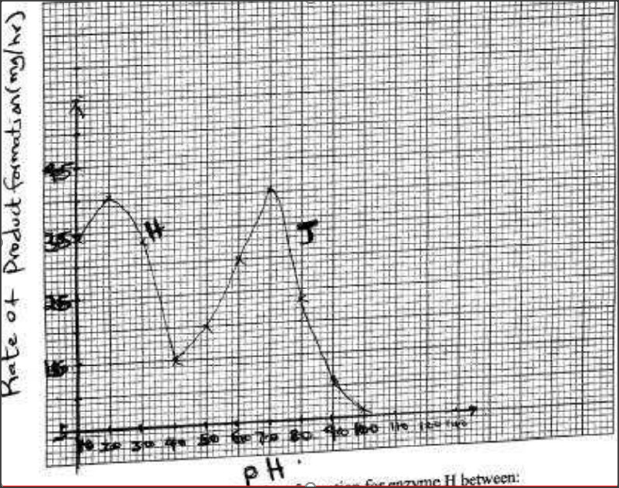

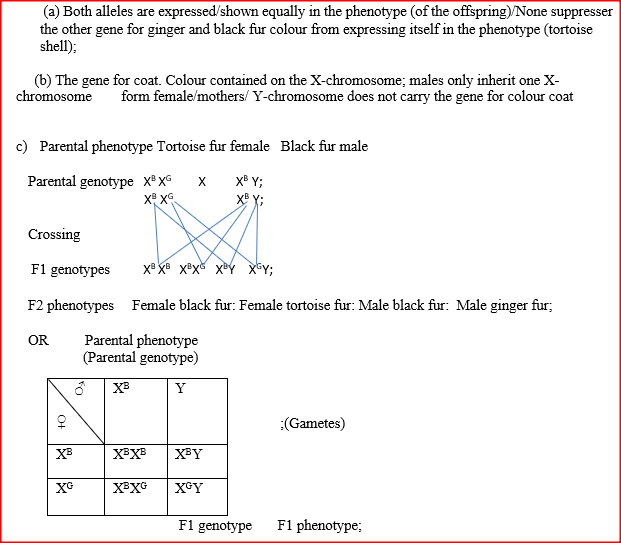
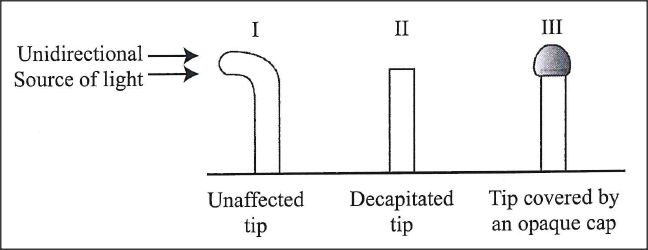


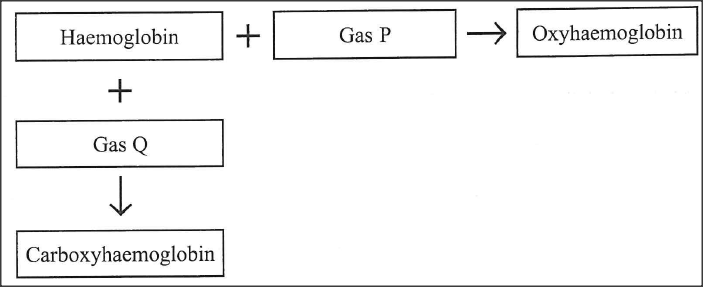
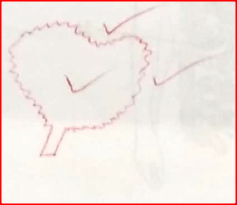
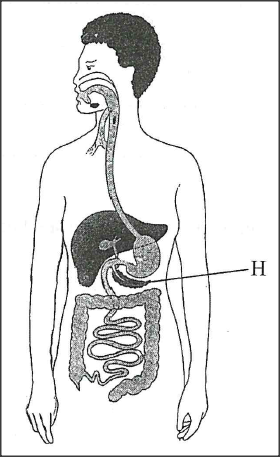
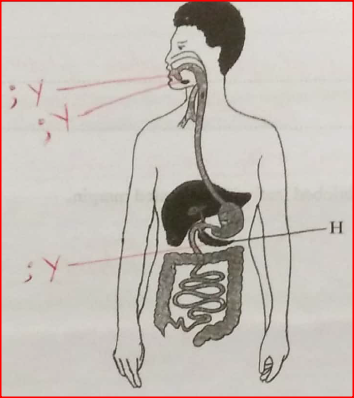








 RSS Feed
RSS Feed